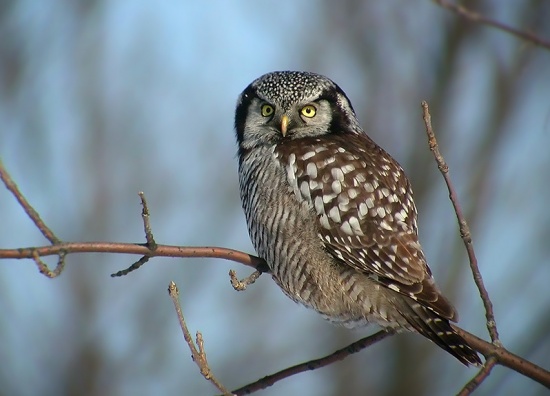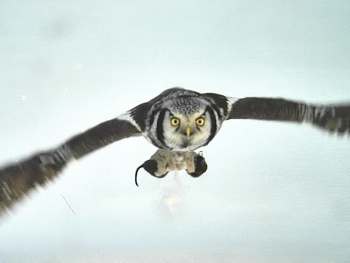
- Surnia ulula
Identification
L 35-43 cm (13¾-17 in), WS 69-82 cm.
- Long, rounded tail with white stripes
- Barred underparts
- Large round head with no ear tufts
- Eyes and bill are yellow
- Thick black stripe framing each side of its whitish face
- Forehead is spotted white
- Breast is whitish with dark brown horizontal stripes
Distribution
Northern circumpolar.
Taxonomy
Subspecies
Three subspecies are recognized[1]:
- S. u. caparoch:
- Alaska to Canada, Newfoundland and extreme northern US
- S. u. ulula:
- Northern Eurasia
- S. u. tianschanica:
Habitat
Boreal forests, preferring vicinity of bog, meadow or clearfell.
Behaviour
Rather hawklike, smaller than American Crow. Does not sit as erect as other owls. Often perches at the top of a tree and frequently jerks its tail up and slowly lowers it. Shrikelike, it flies low, rising abruptly to its perch.
Diurnal hunter, calls at night
Diet
Food voles (main prey, taken on ground after watch from treetop) and birds (e.g. thrushes; capable of catching prey as large as Willow Grouse).
Breeding
Nests inside woodpecker holes or rotting trees, also abandoned crow, hawk, and squirrel nests. Clutch of 3 - 10 eggs are laid and incubated by the female for 25 - 30 days. After the young hatch it takes another 25 - 30 days before they leave the nest.
Vocalisation
References
- Clements, J. F., T. S. Schulenberg, M. J. Iliff, D. Roberson, T. A. Fredericks, B. L. Sullivan, and C. L. Wood. 2017. The eBird/Clements checklist of birds of the world: v2017, with updates to August 2017. Downloaded from http://www.birds.cornell.edu/clementschecklist/download/
- Answers.com
- Collins Field Guide 5th Edition
Recommended Citation
- BirdForum Opus contributors. (2025) Northern Hawk-Owl. In: BirdForum, the forum for wild birds and birding. Retrieved 18 May 2025 from https://www.birdforum.net/opus/Northern_Hawk-Owl
External Links
GSearch checked for 2020 platform.1




